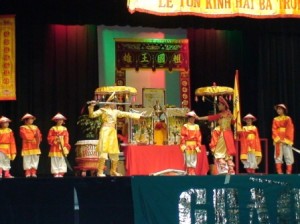Chúc may mắn. Good luck. In both Vietnamese and Chinese cultures, the New Year is rung in with family, and with the hope that this next year will bring them luck. Vietnamese and Chinese students do not ring in the new year at midnight on Jan. 1. Instead, they will celebrate when there is a new moon in the sky, on Feb. 10. The date changes every year, according to a lunar calendar, but the traditions stay the same.
Senior Gina Nguyen celebrates Vietnamese New Year, and observes the yearly traditions. Most people clean their houses, “have incense burning, [and] play Vietnamese music,” Nguyen said.
Vietnamese New Year, also called Tet, is a time to remember ancestors and celebrate the New Year with family. It is both religious and cultural. Tet spans days before the actual New Year, with family visits, decorating, and cooking traditional Tet food.

At Vietnamese parties during this time of year, there are dragon dances, performances, and fashion shows. “It’s mostly performances and catching up with people,” Nguyen said.
Another staple of Tet is lì xi, little red envelopes that children receive with money inside. The red color of the envelope symbolizes good luck. “You would always give those to the little kids,” Nguyen said, “and when the dragon dances are going on the little kids feed it to the dragon.”
Chinese New Year falls on the same day as Tet because they share the same lunar calendar. It begins on the new moon and lasts 15 days, ending with the full moon. Each day corresponds with specific traditions. On the 15th day, there is a Lantern Festival where families decorate lanterns and release them into the sky.
Alicia Zhang celebrates Chinese New Year, and says her favorite part about the day is the food. “I especially love the dumplings and rice,” she said. Even though she doesn’t do this, “I know lots of people set off fireworks on New Year’s.”
Another part of New Year’s for Zhang is getting phone calls from relatives and calling them back, wishing each other a happy New Year’s.
Families and friends exchange gifts throughout the New Year, which traditionally include oranges, a red envelope with money, similar to the li xi, and candied fruit or cookies.
Along with traditions come superstitions. One superstition is not wearing black or white, both colors that represent death in Chinese culture.
Vietnamese and Chinese New Year celebrate good luck in the coming year and both carry cultural importance. They are a time to remember the old year and look forward to good health, good fortune, and good luck this year. 祝你新年快乐. Happy New Year.